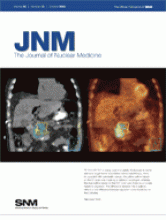Abstract
Visilizumab is an IgG2 humanized monoclonal antibody (mAb) characterized by non-FcγR binding and specific to the CD3 antigen, expressed on more than 95% of circulating resting T-lymphocytes and on activated T-lymphocytes homing in inflamed tissues. We hypothesized that the use of a radiolabeled anti-CD3 antibody might serve as a diagnostic tool for imaging T-cell traffic and lymphocytic infiltration of tissues and organs affected by autoimmune diseases. Here we describe the results of in vitro and animal experiments with 99mTc-succinimidyl-6-hydrazinonicotinate hydrochloride (SHNH)–visilizumab. Methods: For mAb labeling, we used a 2-step method with a heterobifunctional linker SHNH. Several titrations were performed to obtain the best labeling efficiency. In vitro quality controls included stability assay, cysteine challenge, sodium dodecyl sulfate polyacrylamide gel electrophoresis, binding assay, and immunoreactivity assay. In vivo studies by high-resolution images were performed at 6 and 24 h after the injection of 99mTc-SHNH–visilizumab. These included cell-targeting experiments in BALB/c mice xenografted subcutaneously with an increasing number of HuT78 cells in the leg and displaced with an excess of cold antibody. We also studied irradiated severe combined immunodeficient (SCID) mice reconstituted with human peripheral blood mononuclear cells (hPBMCs) and injected with 99mTc-labeled visilizumab or control mAb. After dynamic imaging for 3 h, major organs were removed, counted, and processed for immunohistologic examination. Results: Visilizumab was labeled with HYNIC with high labeling efficiency (>90%) and high specific activity (SA; 10,360–11,100 MBq/mg), with retained biochemical integrity and in vitro binding activity to CD3-positive cells. The in vivo targeting experiment showed a proportional increase of specific uptake with the number of injected cells, both at 6 and at 24 h, and the in vivo competition study demonstrated more than 60% decreased uptake after an excess of unlabeled antibody. In SCID mice, hPBMCs in different tissues were detected by 99mTc-labeled visilizumab and confirmed by histology. Conclusion: Visilizumab can be efficiently labeled with 99mTc with high efficiency and SA and could be a valuable tool for the study of human T-lymphocyte trafficking and lymphocytic infiltration of tissues and organs.
Footnotes
-
COPYRIGHT © 2009 by the Society of Nuclear Medicine, Inc.







